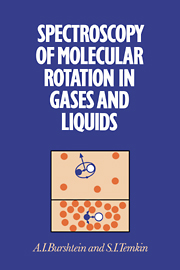Book contents
- Frontmatter
- Contents
- 0 Introduction
- 1 Rotational relaxation
- 2 Orientational relaxation in dense media
- 3 Transformation of isotropic scattering spectra
- 4 Quantum theory of spectral collapse
- 5 Rotational relaxation: kinetic and spectral manifestations
- 6 Impact theory of orientational relaxation
- 7 Rotation and libration in a fluctuating cell
- Appendix 1
- Appendix 2
- Appendix 3
- Appendix 4
- Appendix 5
- Appendix 6
- Appendix 7
- Appendix 8
- Appendix 9
- References
- Index
3 - Transformation of isotropic scattering spectra
Published online by Cambridge University Press: 06 November 2009
- Frontmatter
- Contents
- 0 Introduction
- 1 Rotational relaxation
- 2 Orientational relaxation in dense media
- 3 Transformation of isotropic scattering spectra
- 4 Quantum theory of spectral collapse
- 5 Rotational relaxation: kinetic and spectral manifestations
- 6 Impact theory of orientational relaxation
- 7 Rotation and libration in a fluctuating cell
- Appendix 1
- Appendix 2
- Appendix 3
- Appendix 4
- Appendix 5
- Appendix 6
- Appendix 7
- Appendix 8
- Appendix 9
- References
- Index
Summary
As is seen from relations (2.5)–(2.8), isotropic scattering is independent of orientational relaxation. Since the isotropic component of the polarization tensor is invariant to a molecule's reorientation, the corresponding correlation function K0 describes purely vibrational relaxation. This invariance does not mean however that vibrational relaxation is completely insensitive to angular momentum relaxation. Interaction between vibrations and a molecule's rotation determines the rotational structure of the isotropic scattering spectra observed in highly rarefied gases. The heavier the molecule, the smaller is the constant αe of the Q-branch rotational structure. In fact this thin structure is easily resolved only in hydrogen and deuterium. The isotropic Raman spectrum of most other gases is usually unresolved even at rather low pressure and when describing its shape at higher densities one may consider J a classical (continuous) variable.
Within the framework of the impact theory J(t) is a purely discontinuous Markovian process. The same is valid for the corresponding frequency, or ‘rotational component’, which changes its position in the spectrum after each collision. This phenomenon, known as spectral diffusion or rotational frequency exchange, is accompanied by adiabatic dephasing of the vibrational transition caused by these same collisions. Both processes contribute to observed spectral transformation with increasing collision frequency, however they have opposite effects. While frequency exchange leads to collisional narrowing, dephasing results in the spectrum-broadening. If dephasing is weak and the collision frequency is small, the tendency for the spectrum to narrow prevails.
- Type
- Chapter
- Information
- Spectroscopy of Molecular Rotation in Gases and Liquids , pp. 92 - 126Publisher: Cambridge University PressPrint publication year: 1994



